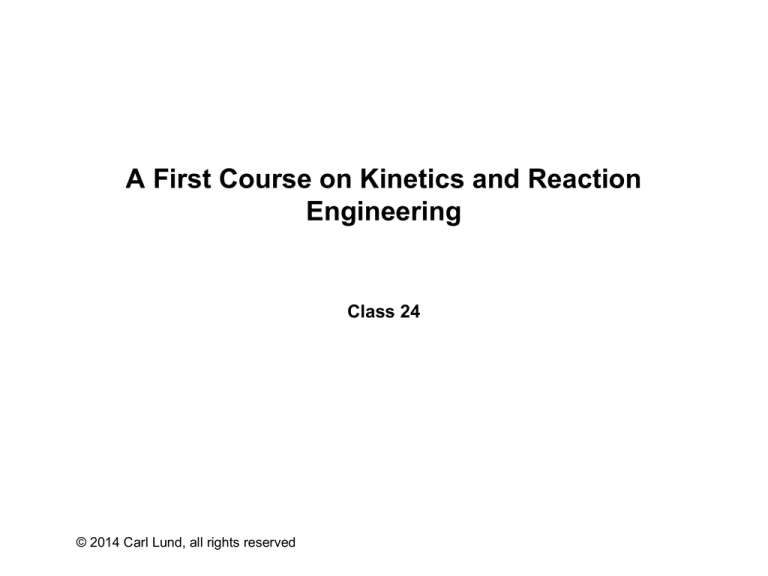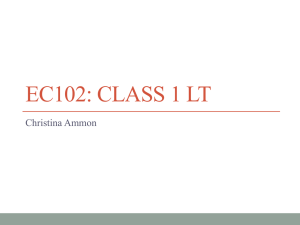
A First Course on Kinetics and Reaction
Engineering
Class 24
© 2014 Carl Lund, all rights reserved
Where We’re Going
• Part I - Chemical Reactions
• Part II - Chemical Reaction Kinetics
• Part III - Chemical Reaction Engineering
‣ A. Ideal Reactors
‣ B. Perfectly Mixed Batch Reactors
‣ C. Continuous Flow Stirred Tank Reactors
-
21. Reaction Engineering of CSTRs
22. Analysis of Steady State CSTRs
23. Analysis of Transient CSTRs
24. Multiple Steady States in CSTRs
‣ D. Plug Flow Reactors
‣ E. Matching Reactors to Reactions
• Part IV - Non-Ideal Reactions and Reactors
Satisfying the Steady State CSTR
Energy Balance
• Choose an outlet temperature,
•
•
solve the mole balance design
equations, use results to compute
two parts of the energy balance,
plot the results
Energy balance is only satisfied at
temperatures where the two curves
intersect
In this case there are three
solutions to the steady state CSTR
design equations
‣ In all three cases the outlet temperature
and outlet molar flow rates make sense
physically
‣ Known as multiplicity of steady states
CSTR Steady States
• Suppose the system was perturbed
slightly away from a given steady
state, would it tend naturally to
return to that steady state
C
‣ if so, it’s a stable steady state (Points A &
C)
‣ if not, it’s an unstable steady state. (Point
B)
• Real systems won’t operate
B
A
•
naturally at an unstable steady
state
The start-up or most recent
transient will determine which
steady state is reached
‣ Reactor design must include a safe and
efficient start-up procedure that will bring
the system to the desired steady state
• System is typically designed to
operate at one of the steady states,
not the other
Questions?
Activity 24.1
Consider an adiabatic, steady state CSTR with a fluid volume of 0.4 L.
Suppose the liquid phase reaction A → Z takes place in the reactor. The
feed to the reactor is at 330 K; it flows at 1 L min-1 and it contains 5 mol A L1. The heat capacity of the solution is 1000 cal L-1 K-1, and it independent of
both temperature and composition. The reaction is exothermic with a heat of
-30,000 cal mol-1. The rate is first order in the concentration of A. The preexponential factor equals 4.8 x 1013 min-1 and the activation energy is 24,000
cal mol-1.
Write the steady-state mole balance on A and the energy balance for this
reactor. Set up an Excel spreadsheet where each of the values given above
are listed at the top. Then add columns for the outlet temperature, the outlet
molar flow rate of A, the heat absorbed term and the heat generated term
(see Unit 24). Fill in the temperature column with values from 250 to 550 K in
steps of 10 K, and then enter formulae to fill in the other columns. Finally, on
the same graph plot the heat absorbed versus T and the heat generated
versus T. Call this your base case. Vary each parameter in the problem
statement and determine how it affects the plot.
Results
• Increasing the volumetric flow rate shifts the heat absorbed curve upward
• Increasing the inlet temperature shifts the heat absorbed curve downward
• Increasing the inlet concentration increases the size of the step in the heat
•
•
•
•
•
generated curve
Increasing the heat capacity decreases the size of the step in the heat
generated curve
Increasing the reaction volume shifts the step of the heat generated curve
to lower temperature
Increasing the heat of reaction (making it less negative) decreases the
size of the step in the heat generated curve
Increasing the pre-exponential factor shifts the step of the heat generated
curve to lower temperature
Increasing the activation energy shifts the step of the heat generated
curve to higher temperature
Activity 24.2
• Choose a set of conditions from Activity 24.1 where the reactor displays
•
•
three steady states
Write the steady state mole balance and energy balance design equations
for that CSTR
Set up a MATLAB or other computer code to solve the design equations
and use it to find all three steady states
Where We’re Going
• Part I - Chemical Reactions
• Part II - Chemical Reaction Kinetics
• Part III - Chemical Reaction Engineering
‣ A. Ideal Reactors
‣ B. Perfectly Mixed Batch Reactors
‣ C. Continuous Flow Stirred Tank Reactors
-
21. Reaction Engineering of CSTRs
22. Analysis of Steady State CSTRs
23. Analysis of Transient CSTRs
24. Multiple Steady States in CSTRs
‣ D. Plug Flow Reactors
-
25. Reaction Engineering of PFRs
26. Analysis of Steady State PFRs
27. Analysis of Transient PFRs
‣ E. Matching Reactors to Reactions
• Part IV - Non-Ideal Reactions and Reactors












